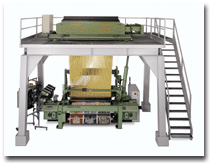Industry InterviewBy Jim Phillips Range Of Opportunities
Sulzer Textil maintains a distinct brand of product, performance and
innovation. Sulzer Textil, the venerable Swiss weaving machine manufacturer, was acquired
last year by the Radici-owned Itema Group, an Italian company that is also the parent of Promatech,
which manufactures and markets Somet and Vamatex weaving machines.Speculation has run rampant
through the industry about just what the ultimate fate of Sulzer will be. Often, when a leading
company is acquired by its competition, the product offerings of both begin to blur into a single,
homogenous line with little difference other than nameplates.

To find out whats in store for Sulzer as part of the Itema Group,
Textile World sat down with Paolo G. Antonietti, president, Sulzer Textil Group, and
talked about the opportunities and challenges ahead.We are completely interested that the Sulzer
brand name remains on our machines, advertisements, distribution channels, and with all of our
agencies and sales people, Antonietti said. The brand name is very well-recognized all over the
world. Sulzer Textil is linked to service after sales to our customers, so we are very willing to
promote and continue this brand. Market LeaderThe brand will flourish as more than a name,
however. Sulzer, as a leader in this market, will continue to bring innovation and new products on
the market, he said. Just this last year, we brought to OTEMAS and ITMA a completely new projectile
machine, the G6300. We brought a new terry rapier machine. The terry market is a very big market
for us. We are the absolute leader in terry fabrics, and we have to continue to innovate. “We have
a new version of the multiphase machine, the M8300 version B-12. Thats three new machines at the
exhibitions. I am not promising we will have three new machines in Birmingham [ITMA 03]. However,
for sure well have some very interesting novelties for our customers there. You know, if we look at
the amount or the size of our R and D department, it is amazing. If you bring together Sulzer and
Promatech, we have 310 engineers for R and D.

Sulzer’s G6200 weaving machine with a Grosse electronic jacquard headIn air-jet weaving,
Sulzer plans to continue its long-standing arrangement with Toyota. This has been a very successful
collaboration in the past, Antonietti said. From our side the Sulzer Textil side it is all research
and development, and we have a lot of know-how in air-jet technology. On the other hand, Toyota has
very good manufacturing, a very efficient assembly line and the low cost of production,
manufacturing and assembling. We think the two partners bring to the project a very important and
very economic asset, and so we have extended our collaboration. However, it is restricted to
air-jet looms. Antonietti said Sulzer has a unique position in the market because it has a
full range of machines in its program. That means we are exclusively selling projectile machines,
we are exclusively selling multiphase machines. From the projectile and multiphase machines, we go
to the rapier and air-jet, so we have the full product portfolio to offer our customers. This
enables us to weave the most complicated technical textiles, very heavy and very large, extra-width
applications, up to the most simple fabrics where production speed and output are the key
issues.”Other manufacturers are cruising on the rapier or air-jet, so they cannot serve the high,
demanding, technical and very specific applications for glass fibers or other application where you
need projectile looms. At the same time, they run at the maximum air-jet speed limit of 2,500
meters per minute (m/min). We are more than double that with the multiphase machine. We can
approach any kind of customer in terms of product portfolio, while our competitors only focus on
one specific issue. Multiphase CapabilityThe Sulzer M8300 multiphase machine, which enables
multiple weft insertion, is targeted toward mass production of simple fabrics, he said. Today, this
production is mainly done with projectile or air-jet machines, but customers want to have a greater
output. They want to reduce energy consumption. Air-jet machines are very expensive to run.
Customers want to have a restricted area for buildings. That means they want to have more
production in existing premises. They also want to reduce costs for personnel. “To have the same
personnel attending much faster machines, we had to develop a technology that was completely
revolutionary. We have four wefts inserting at the same time, so we are going to be much faster
than any air-jet machine. The future is definitely clear there. However, we have to be very clear
here: this is not the machine for fashion-oriented fabrics, for wool, silk, technical applications
or for very large, double-width applications. This machine is for commodity products, where you
only look for volume and want to reduce your cost of production. Geographic MarketsAs far as
markets for the machine go, the Far East has a great deal of potential, as well as India and
Pakistan. Today, any investment in the area of commodity fabrics has to take into account the
multiphase machine. Of course, prerequisites are important. First, the customer must really focus
his product range into the commodities market. “Secondly, he must be ready to invest not only in
the machine, but also in the infrastructure to optimize this kind of machinery. This is mainly
logistics and air-cleaning devices. He must be in a market where he can run longer production runs,
which means the order he gets from his customer must be stable, without frequent stops, article
changes and so on. This is because the machine has such a production output that you have to be
sure that you continue to produce without changing the article. Otherwise, your investment doesnt
pay off. Latin America Buys Long-TermIn addition to the Far East, which is buying many used
Sulzer machines, as well as state-of-the-art machinery, Sulzer has a large presence in Latin
America. Sulzer has big stakes in Latin America. Latin American companies invest for the long-term.
They are not investing like the Chinese, in machines that depreciate in a short term and are going
to be replaced in a few years. Latin American customers generally run Sulzer machines for 30 years
or more. We have a lot of installations with projectile machines running at an efficiency ratio of
96-98 percent. There are a number of reasons they run machines for so long. “First, the import
duties are very high in Latin America, and once you import such equipment, you want to be sure you
can run with this machine in the long term. Secondly, in Latin America, customers are typically
looking to have a machine that has high versatility and capacity to change articles, to be ready to
weave different styles. So typically, Latin America is an area where Sulzer projectile machines
have an ideal position.”Another issue is that the projectile machine has very low energy
consumption and, in a country like Brazil, this is a major issue. Another strong point is our
after-sale service that provides the customer reliability over time. He is not only interested that
the machine runs the first day when it is installed, but that the machine runs perfectly after 30
years and that he can get spare parts, maintenance and upgrading support from our technicians.In
addition to the Far East and Latin America, Sulzer remains committed to the North American market,
Antonietti said. We will continue our investment in our subsidiary in Spartanburg, he said. We are
very proud of our American operation. It is a profitable organization. We still have our continuous
business in the States.
August 2002




